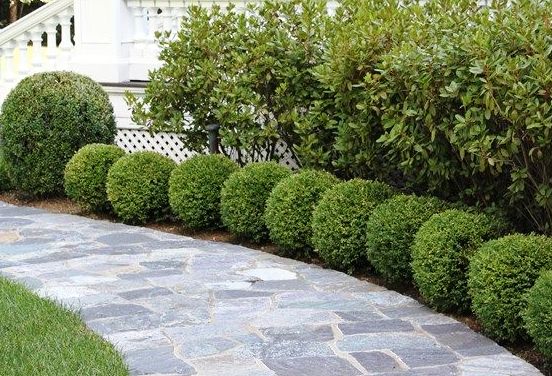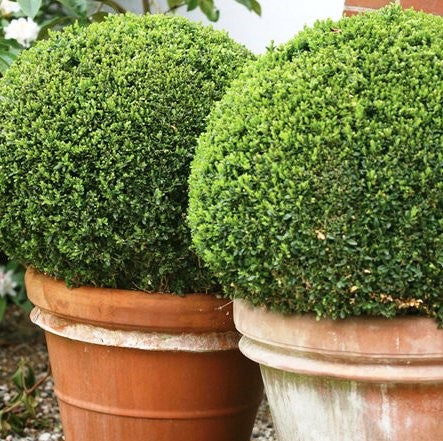By Ken Lain, the mountain gardener

The Buxus genus includes about 70 species of slow-growing broadleaf evergreens. Most varieties used in mountain landscaping are dwarf varieties. These dwarf boxwood shrubs are prized for their densely packed, light-green leaves and rounded compact growth habit.
Botanical Name Buxus
Common Names Boxwood, English boxwood, box
Plant Type Evergreen shrub
Mature Size Dwarf varieties are typically knee to hip height
Sun Exposure 4+ hours of Full sun
Soil Type Medium moisture loamy soil
Soil pH 6.8 to 7.5
Bloom Time April to May
Flower Color Green to creamy yellow (flowers are not significant)
Hardiness Zones 5 to 9
Native Area Southern Europe, Asia
How to Grow Boxwood Shrubs
Boxwoods are best planted in loamy soil in a full-sun to part-shade location. Their roots are shallow, so the ground must be protected from the heat. Maintain a 3″ layer of Watters Premium Mulch to prevent sunburning of the soil’s roots. Keep the garden soil cool by spreading this 3″ layer of mulch one foot around the plant.

![]() Light
Light
Boxwoods grow in most mountain landscapes. The thick, lustrous foliage is best grown in 4+ hours of full sun during the growing season.
Soil
Boxwood shrubs require well-drained soils, or they will suffer from root rot. Although they may tolerate soils with a lower pH, they prefer alkaline soils with a pH of 6 to 8.
Water
Along with adequate drainage, Boxwood grows best in moderately moist soil. Irrigate young plants twice a week to maintain soil moisture. Once established, it becomes more tolerant of dry conditions.
Temperature and Humidity
Boxwoods typically thrive in the climate conditions in zones 6 to 8. In scorching summer weather, the shrubs will appreciate more water and shade. Zone 5 gardeners may find that stem tips die back in cold weather.
Fertilizer
Feed with Watters 7-4-4 All Purpose Food 3 times per year (March, July, and October) for denser foliage and deeper green color.
Propagating Boxwood Shrubs
Boxwood is best propagated by rooting stem cuttings. In midsummer, cut 3′ inch lengths of stem tips off new growth. Remove the lower leaves and scape the bark from one side of the cutting. Dip the cut end in ‘Rooting Powder’ to prevent stem rot and stimulate new root formation. Then plant directly into a container filled with seedling potting soil. Moisten the potting soil and set your plant in a bright location. Check the moisture daily and mist whenever dry. Check for roots every few days by tugging on the cutting.
When the roots are sufficiently developed, transplant your cutting into a larger container filled with Watters Potting Soil. Continue to grow the plant in a sunny window until outdoor planting time the following spring.
Pruning Boxwood Shrubs
Although they are known for their tolerance for hard pruning, most boxwoods will form an excellent informal shape without much pruning at all. Only occasional pruning is required to clean out dead branches or those that are twisted together. When pruning hard for form, trimming can be done almost any time. However, pruning should be avoided in late fall to prevent winter bronzing.
Varieties of Boxwood
There are many kinds of boxwoods, and the best plant for you depends on your particular landscape use.
- Buxus microphylla ‘Golden Triumph’ is 2′ feet tall X 3′ feet wide; it is valued for its variegated leaves.
- Buxus microphylla var. japonica, the Japanese Boxwood, is one of the most popular shrubs for low hedges. It is also preferred where a more drought-tolerant shrub is needed. Growing in zones 6 to 9 and has mature dimensions of 6′ feet tall X 10′ feet wide. Japanese boxwoods figure prominently at many historic sites in the Far East.
- Buxus microphylla ‘Winter Gem’is 4′ feet tall with a similar spread. The cultivar name comes from the pleasing gold and bronze tinges of its foliage in winter.
- Buxus sempervirens ‘Monrue Green Tower’ is a columnar form, 9 feet tall X 1′ feet wide. It is excellent for a tall screen or for sculpting topiary use. Widespread use is two plants used to flank an entryway.
- Buxus sempervirons ‘Suffruticosa’ cultivars are favored in gardens because they grow more slowly. These shrubs grow to 2′ feet in height X 2′ feet wide.
Pests/Diseases
A common problem for boxwood shrub is winter bronzing, a shift to reddish-brown or yellowish foliage color caused by winter exposure to wind and sun. One way to address the problem is to spray an anti-desiccant like Wiltstop on the foliage late November and again in late January.
Leafminer, boxwood mite, and boxwood psyllid are common pests. These pests can all be cured by spraying infected plants with Watters Multi-Purpose Insect Spray. Boxwoods can be susceptible to fungal blights and leaf spot, and root rot can also be a problem in poorly-drained soils.
Toxicity of Boxwood
All parts of a boxwood plant are toxic and can cause nausea, vomiting, diarrhea, convulsions, and even respiratory failure if ingested. But ingestion is rare, as this plant has no attractive berries, and the leaves just taste bad.
Landscape Uses
Boxwood shrubs are more often grouped together in foundation plantings or to form low hedges. Dwarf boxwoods are famous for their use in formal Cottage or English style landscapes. They respond well to pruning, making them popular as topiary and bonsai plants.
Other uses for these bushes extend beyond the life of the plant. As a cut evergreen for the holiday season, sprigs of it are used in wreaths, garlands, kissing balls, and topiary “tree” arrangements.
How to Plant a Boxwood
Companion Plants with Boxwood for a Stunning Backyard
Arizona Cypress
Austrian Pine
Mint Julip Juniper
Red Cluster berry Cotoneaster
Yew

